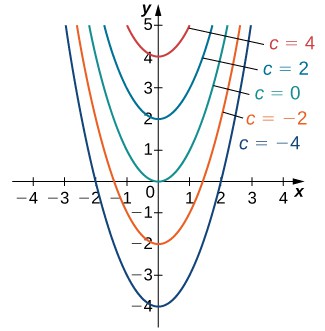Learning Outcomes
- Identify the order of a differential equation
- Explain what is meant by a solution to a differential equation
- Distinguish between the general solution and a particular solution of a differential equation
General Differential Equations
Consider the equation [latex]{y}^{\prime }=3{x}^{2}[/latex], which is an example of a differential equation because it includes a derivative. There is a relationship between the variables [latex]x[/latex] and [latex]y\text{:}y[/latex] is an unknown function of [latex]x[/latex]. Furthermore, the left-hand side of the equation is the derivative of [latex]y[/latex]. Therefore we can interpret this equation as follows: Start with some function [latex]y=f\left(x\right)[/latex] and take its derivative. The answer must be equal to [latex]3{x}^{2}[/latex]. What function has a derivative that is equal to [latex]3{x}^{2}?[/latex] One such function is [latex]y={x}^{3}[/latex], so this function is considered a solution to a differential equation.
Definition
A differential equation is an equation involving an unknown function [latex]y=f\left(x\right)[/latex] and one or more of its derivatives. A solution to a differential equation is a function [latex]y=f\left(x\right)[/latex] that satisfies the differential equation when [latex]f[/latex] and its derivatives are substituted into the equation.
Interactive
Go to this website to view demonstrations of differential equations.
Some examples of differential equations and their solutions appear in the following table.
| Equation | Solution |
|---|---|
| [latex]y^{\prime} =2x[/latex] | [latex]y={x}^{2}[/latex] |
| [latex]y^{\prime} +3y=6x+11[/latex] | [latex]y={e}^{-3x}+2x+3[/latex] |
| [latex]y^{\prime} \prime -3y^{\prime} +2y=24{e}^{-2x}[/latex] | [latex]y=3{e}^{x}-4{e}^{2x}+2{e}^{-2x}[/latex] |
Note that a solution to a differential equation is not necessarily unique, primarily because the derivative of a constant is zero. For example, [latex]y={x}^{2}+4[/latex] is also a solution to the first differential equation in the table. We will return to this idea a little bit later in this section. First, we briefly review the rules for derivatives of exponential functions, and then explore what it means for a function to be a solution to a differential equation.
Recall: Derivatives of Exponential Functions
- [latex]\frac{d}{dx} \left( e^x \right) = e^x[/latex]
- [latex]\frac{d}{dx} \left( e^{g(x)} \right) = e^{g(x)}g'(x)[/latex] (this is the chain rule applied to the derivative of an exponential function)
Example: Verifying Solutions of Differential Equations
Verify that the function [latex]y={e}^{-3x}+2x+3[/latex] is a solution to the differential equation [latex]{y}^{\prime }+3y=6x+11[/latex].
Watch the following video to see the worked solution to Example: Verifying Solutions of Differential Equations
You can view the transcript for “4.1.2” here (opens in new window).
try it
Verify that [latex]y=2{e}^{3x}-2x - 2[/latex] is a solution to the differential equation [latex]{y}^{\prime }-3y=6x+4[/latex].
It is convenient to define characteristics of differential equations that make it easier to talk about them and categorize them. The most basic characteristic of a differential equation is its order.
Definition
The order of a differential equation is the highest order of any derivative of the unknown function that appears in the equation.
Example: Identifying the Order of a Differential Equation
What is the order of each of the following differential equations?
- [latex]{y}^{\prime }-4y={x}^{2}-3x+4[/latex]
- [latex]{x}^{2}y\text{'''}-3xy\text{''}+x{y}^{\prime }-3y=\sin{x}[/latex]
- [latex]\frac{4}{x}{y}^{\left(4\right)}-\frac{6}{{x}^{2}}y\text{''}+\frac{12}{{x}^{4}}y={x}^{3}-3{x}^{2}+4x - 12[/latex]
Watch the following video to see the worked solution to Example: Identifying the Order of a Differential Equation
You can view the transcript for “4.1.1” here (opens in new window).
try it
What is the order of the following differential equation?
General and Particular Solutions
We already noted that the differential equation [latex]{y}^{\prime }=2x[/latex] has at least two solutions: [latex]y={x}^{2}[/latex] and [latex]y={x}^{2}+4[/latex]. The only difference between these two solutions is the last term, which is a constant. What if the last term is a different constant? Will this expression still be a solution to the differential equation? In fact, any function of the form [latex]y={x}^{2}+C[/latex], where [latex]C[/latex] represents any constant, is a solution as well. The reason is that the derivative of [latex]{x}^{2}+C[/latex] is [latex]2x[/latex], regardless of the value of [latex]C[/latex]. It can be shown that any solution of this differential equation must be of the form [latex]y={x}^{2}+C[/latex]. This is an example of a general solution to a differential equation. A graph of some of these solutions is given in Figure 1. (Note: in this graph we used even integer values for [latex]C[/latex] ranging between [latex]-4[/latex] and [latex]4[/latex]. In fact, there is no restriction on the value of [latex]C[/latex]; it can be an integer or not.)

Figure 1. Family of solutions to the differential equation [latex]{y}^{\prime }=2x[/latex].
In this example, we are free to choose any solution we wish; for example, [latex]y={x}^{2}-3[/latex] is a member of the family of solutions to this differential equation. This is called a particular solution to the differential equation. A particular solution can often be uniquely identified if we are given additional information about the problem.
Example: Finding a Particular Solution
Find the particular solution to the differential equation [latex]{y}^{\prime }=2x[/latex] passing through the point [latex]\left(2,7\right)[/latex].
Watch the following video to see the worked solution to Example: Finding a Particular Solution
You can view the transcript for “4.1.3” here (opens in new window).
try it
Find the particular solution to the differential equation
passing through the point [latex]\left(1,7\right)[/latex], given that [latex]y=2{x}^{2}+3x+C[/latex] is a general solution to the differential equation.
Try It
Candela Citations
- 4.1.2. Authored by: Ryan Melton. License: CC BY: Attribution
- 4.1.1. Authored by: Ryan Melton. License: CC BY: Attribution
- 4.1.3. Authored by: Ryan Melton. License: CC BY: Attribution
- Calculus Volume 2. Authored by: Gilbert Strang, Edwin (Jed) Herman. Provided by: OpenStax. Located at: https://openstax.org/books/calculus-volume-2/pages/1-introduction. License: CC BY-NC-SA: Attribution-NonCommercial-ShareAlike. License Terms: Access for free at https://openstax.org/books/calculus-volume-2/pages/1-introduction
